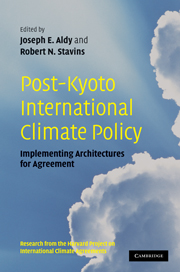Book contents
- Frontmatter
- Contents
- Harvard Environmental Economics Program, International Advisory Board
- Harvard Project on International Climate Agreements, Faculty Steering Committee
- Harvard Project on International Climate Agreements, Project Management
- List of figures
- List of tables
- List of contributors
- Foreword
- 1 Introduction
- Part I Alternative international policy architectures
- 2 An elaborated proposal for a global climate policy architecture: specific formulas and emission targets for all countries in all decades
- 3 The EU emission trading scheme: a prototype global system?
- 4 Linkage of tradable permit systems in international climate policy architecture
- 5 The case for charges on greenhouse gas emissions
- 6 Towards a global compact for managing climate change
- 7 Sectoral approaches to a post-Kyoto international climate policy framework
- 8 A portfolio system of climate treaties
- Part II Negotiation, assessment, and compliance
- Part III The role and means of technology transfer
- Part IV Global climate policy and international trade
- Part V Economic development, adaptation, and deforestation
- Part VI Modeling impacts of alternative allocations of responsibility
- Part VII Synthesis and conclusion
- Appendix A Selected List of Individuals Consulted, Harvard Project on International Climate Agreements
- Appendix B Workshops and Conferences, Harvard Project on International Climate Agreements
- Glossary and Abbreviations
- Index
5 - The case for charges on greenhouse gas emissions
Published online by Cambridge University Press: 05 June 2012
- Frontmatter
- Contents
- Harvard Environmental Economics Program, International Advisory Board
- Harvard Project on International Climate Agreements, Faculty Steering Committee
- Harvard Project on International Climate Agreements, Project Management
- List of figures
- List of tables
- List of contributors
- Foreword
- 1 Introduction
- Part I Alternative international policy architectures
- 2 An elaborated proposal for a global climate policy architecture: specific formulas and emission targets for all countries in all decades
- 3 The EU emission trading scheme: a prototype global system?
- 4 Linkage of tradable permit systems in international climate policy architecture
- 5 The case for charges on greenhouse gas emissions
- 6 Towards a global compact for managing climate change
- 7 Sectoral approaches to a post-Kyoto international climate policy framework
- 8 A portfolio system of climate treaties
- Part II Negotiation, assessment, and compliance
- Part III The role and means of technology transfer
- Part IV Global climate policy and international trade
- Part V Economic development, adaptation, and deforestation
- Part VI Modeling impacts of alternative allocations of responsibility
- Part VII Synthesis and conclusion
- Appendix A Selected List of Individuals Consulted, Harvard Project on International Climate Agreements
- Appendix B Workshops and Conferences, Harvard Project on International Climate Agreements
- Glossary and Abbreviations
- Index
Summary
The proposal
The proposal discussed in this chapter is to levy a common charge on all emissions of greenhouse gases (GHGs) worldwide. All countries would be covered in principle, but the proposal could be implemented with a much smaller number of countries, provided those countries accounted for most of the global emissions. While all GHGs should in principle be covered, this chapter will address mainly carbon dioxide (CO2), quantitatively the most important GHG; extending charges to other GHGs could be made with little or (in the case of methane) much difficulty. The charge would be internationally adjusted from time to time, and each country would collect and keep the revenue it generated.
This chapter will discuss the motivation for such a proposal; how it would be implemented; its likely economic effects; its relationship to energy security; the possibility of mixing an emission charge with other schemes to limit emissions, especially “cap-and-trade” schemes; and the negotiability of such an agreement.
Motivation
Table 5.1 reports CO2 emissions generated by the use of marketable energy (mainly fossil fuels) in 1990, the base year for the Kyoto Protocol. It also presents emission projections to 2010 (the mid-point of the 2008–2012 first commitment period of the Kyoto Protocol), 2020, and 2030.
- Type
- Chapter
- Information
- Post-Kyoto International Climate PolicyImplementing Architectures for Agreement, pp. 151 - 178Publisher: Cambridge University PressPrint publication year: 2009
- 13
- Cited by

